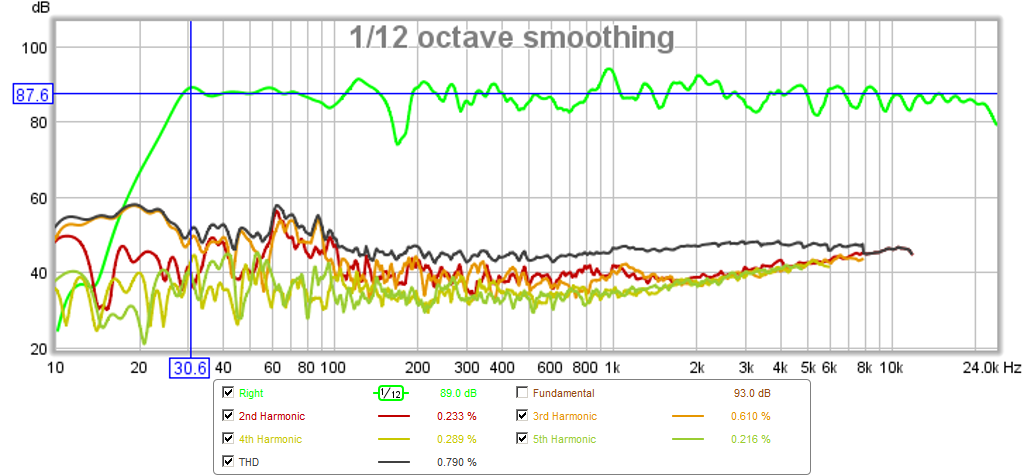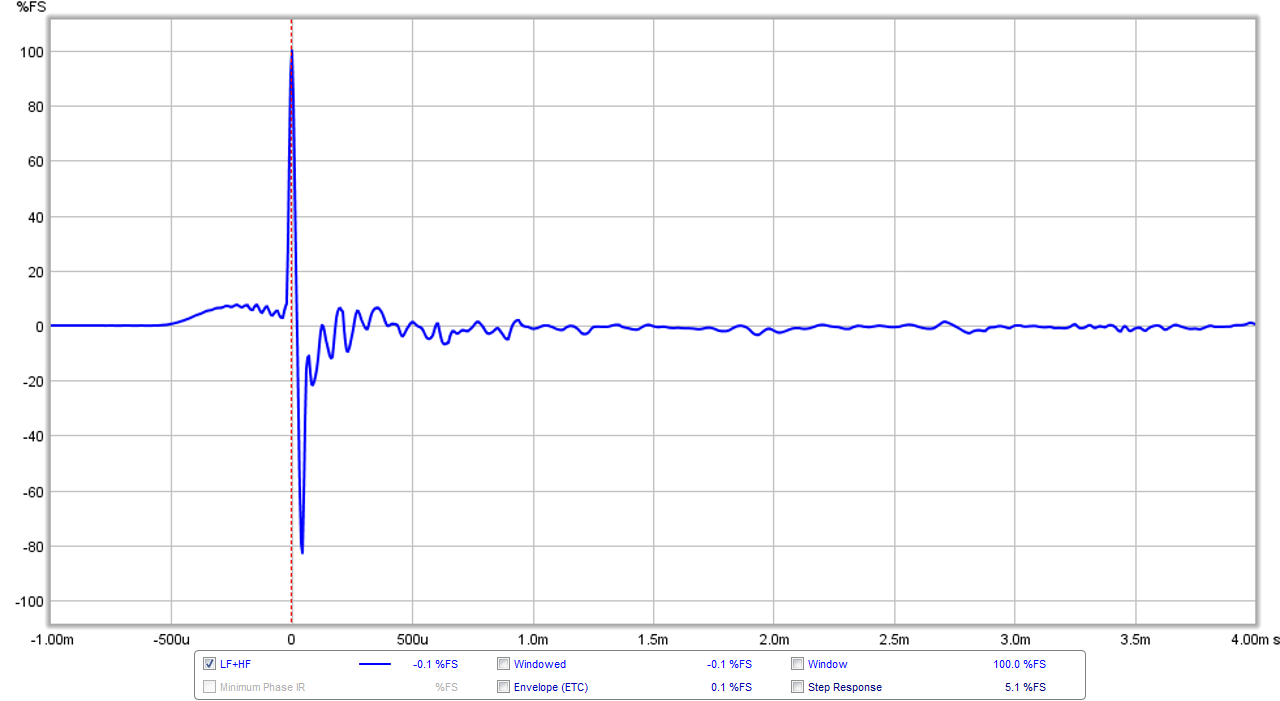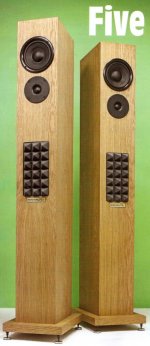Acoustic Induction by designer Jon Carroll on Alacrity Audio Dundee 5 or 6.😀
This weekend I heard the "Acoustic Induction concept" of the TL ( ¼-wave transmission line ?) Alacrity Audio Dundee 5.
Really amazing! No words to describe it...
What is this concept about? Isn't it like a real transmission line or quarter-wave?
What is there more or different from a PMC Transmission Line or others?
Really good in small room audition with very good amps and vinyl system. Really strong bass from amazingly small 135mm mid-bass driver and 20mm soft-dome tweeter 2-way.
Alacrity Audio Dundee 6 loudspeaker is similar with 160/170mm(?) driver.
Reviews; Alacrity Audio’s Loudspeakers | Alacrity Audio
Alacrity Audio Dundee 6 loudspeaker | Hi-Fi+
Read the bottom comment by Alacrity Jon and believe it, I was in that same room (with those speakers) already listening to both jazzy and classical music in vinyl records.
This weekend I heard the "Acoustic Induction concept" of the TL ( ¼-wave transmission line ?) Alacrity Audio Dundee 5.
Really amazing! No words to describe it...
What is this concept about? Isn't it like a real transmission line or quarter-wave?
What is there more or different from a PMC Transmission Line or others?
Really good in small room audition with very good amps and vinyl system. Really strong bass from amazingly small 135mm mid-bass driver and 20mm soft-dome tweeter 2-way.
Alacrity Audio Dundee 6 loudspeaker is similar with 160/170mm(?) driver.
Reviews; Alacrity Audio’s Loudspeakers | Alacrity Audio
Alacrity Audio Dundee 6 loudspeaker | Hi-Fi+
Read the bottom comment by Alacrity Jon and believe it, I was in that same room (with those speakers) already listening to both jazzy and classical music in vinyl records.
Hi.
Their frequency response is; +3dB 20 - 60 Hz, and +/- 1dB 100Hz to 20KHz.
Transients are extremely dynamic ("dynamically, the Dundee6 has no issues." Alan Sircom, HiFi+, issue120), a trade-mark 'sound' of all our loudspeakers.
Not "too warm"; if so, the Dundee6s would not be "extremely good at portraying and projecting vocals" (Alan Sircom, HiFi+, issue120).
Think; perfect mix of sub-bass and full-range satellites.
info at Alacrity Audio dot co dot uk
Idk what exactly that is or even how it works but it reminded me of something I heard a while back...
Atlantic Technology AT-1 loudspeaker | Stereophile.com
Not sure if the principal is the same or what but I do remember being incredibly impressed with the bass from such small drivers
Atlantic Technology AT-1 loudspeaker | Stereophile.com
Not sure if the principal is the same or what but I do remember being incredibly impressed with the bass from such small drivers
More on the principle of the Acoustic Induction Technology
Acoustic Induction | Alacrity Audio
Audio Induction; how it works. | Alacrity Audio
The pyramid acoustic foam panels are not place on the mouth of the TL, this is in the back, but rather on a negative (depression) on the front panels and you can rest them, they are free and not attached, on top(?) of the speakers as I do with my floorstanding Focals to absorb any reflections.
Acoustic Induction | Alacrity Audio
Audio Induction; how it works. | Alacrity Audio
The pyramid acoustic foam panels are not place on the mouth of the TL, this is in the back, but rather on a negative (depression) on the front panels and you can rest them, they are free and not attached, on top(?) of the speakers as I do with my floorstanding Focals to absorb any reflections.
Attachments
Idk what exactly that is or even how it works but it reminded me of something I heard a while back...
Atlantic Technology AT-1 loudspeaker | Stereophile.com
Not sure if the principal is the same or what but I do remember being incredibly impressed with the bass from such small drivers
Interesting article, but a completely different concept as seen through the cut-out picture of the AT1.
Alacrity Audio have overcome internal resonance colouration by allowing (or causing😕) the production of standing waves at every frequency, reasoning that a consistent cabinet performance is better as a background than an inconsistent one.😱
This by virtue of a special open-celled stuffing behind the bass driver.
I'm sure there's a bit more to it (it was awarded a full UK patent), but that's basically 'it'.
cw
I don't know about you but spending several web pages looking for more info on this has resulted in nothing but hyperbole, allusions, similes, and anecdotes and maybe an impedance plot. The impedance plot had two distinct peaks which tells me it's not a critically damped TL like a PMC which would have a squashed double peak verging on being one rounded bump. It's either an TL or reflex hybrid of some sort. But all the pseudo science yaking says it's nothing new and I am tired of them playing hiding the ball.
I made a tapered critically damped TL with a 130mm woofer and a dome tweeter. It sounds very nice and with some room gain reaches an impressive 30Hz with fairly low distortion. Tuning the amount of damping in the TL makes it go from double peak to single peak with two small bumps. When properly dampened - the bass is very clean and tight.
http://www.diyaudio.com/forums/multi-way/281778-low-cost-pmc-inspired-tl-monitor-dc130a-dc28f.html
Here is response and HD from LP at my desk:

And here is impulse response:

I made a tapered critically damped TL with a 130mm woofer and a dome tweeter. It sounds very nice and with some room gain reaches an impressive 30Hz with fairly low distortion. Tuning the amount of damping in the TL makes it go from double peak to single peak with two small bumps. When properly dampened - the bass is very clean and tight.
http://www.diyaudio.com/forums/multi-way/281778-low-cost-pmc-inspired-tl-monitor-dc130a-dc28f.html
Here is response and HD from LP at my desk:

And here is impulse response:

Last edited:
I don't know about you but spending several web pages looking for more info on this has resulted in nothing but hyperbole, allusions, similes, and anecdotes and maybe an impedance plot. The impedance plot had two distinct peaks which tells me it's not a critically damped TL like a PMC which would have a squashed double peak verging on being one rounded bump. It's either an TL or reflex hybrid of some sort. But all the pseudo science yaking says it's nothing new and I am tired of them playing hiding the ball.
I made a tapered critically damped TL with a 130mm woofer and a dome tweeter. It sounds very nice and with some room gain reaches an impressive 30Hz with fairly low distortion. Tuning the amount of damping in the TL makes it go from double peak to single peak with two small bumps. When properly dampened - the bass is very clean and tight.
The plots AA have on their site are for their ported stand-mounts.
You have to look at HiFiWirld magazine to see independent plots of their TL-hybrid floorstanders (30Hertz FLAT from a single 5 and a quarter inch cone), or just read the HiFiChoice review.
You have to hear them to really get them tho (caught their Dundee5 at a hifi show last year. Best in show, if you ask me!).
One hifi show commentator said the bass "stopped me in my tracks" as he was about to leave their room, and that was their smallest standmounts.
Their fame is spreading.
cw
Last edited:
I think I just showed 5.25in woofer TL flat from 30Hz above. So not sure of that is all that difficult. That is at listening position so there are dips due to reflections off desk and computer monitor and keyboard. When measured on a stand away from stuff the response is flat. I guess I have to look at articles in hifi world or whatever but what kind of distortion were they getting?
I'm sure there's a bit more to it (it was awarded a full UK patent), but that's basically 'it'.
If protected by a UK patent it would be nice if a copy of the actual patent application could be made available for download from their website, so that we can see what they have actually done. The currently-available description of "acoustic induction" makes it sound like black magic / marketing hype 🙂.
For example:
"Under “d.c.” acoustic conditions, the bass unit reaches it’s maximum excursion boundary and sits there."
What is that supposed to mean?
https://www.asa.org.uk/Rulings/Adjudications/2012/1/Alacrity-Audio/SHP_ADJ_176028.aspx
They say the patent expired over 10 years ago (the ruling was in 2011). UK patents last 15 years? Then you'd need to search pre 1986
dave
They say the patent expired over 10 years ago (the ruling was in 2011). UK patents last 15 years? Then you'd need to search pre 1986
dave
It's either an TL or reflex hybrid of some sort. But all the pseudo
science yaking says it's nothing new and I am tired of them playing
hiding the ball.
Exactly, this is more a reflex than TL. It's funny and sad at the same time
how easily "blah blah technology" is being presented as groundbreaking
over and over again, backed up by a patent. All I need to see is the drivers
photos and final asking price and everything is clear to me. Strange how
a manufacturer can easily achieve 20 Hz with an 8" PA driver, yet when
a DIYer works with the same technology, then 60 Hz is a fair deal. Where
did the difference go?


BTW I haven't been able to find any patent filed by a person called Jon Carroll.
Regards
Charles
Regards
Charles
AT's H-PAS bass tuning system is described well here Solus Audio Looks nice to me, but I believe it is really tricky to make to work well. AT adds horn profile to exit port.
More about double chamber reflex tuning http://www.diyaudio.com/forums/multi-way/177701-double-chamber-reflex-why-not-used-more-often.html

More about double chamber reflex tuning http://www.diyaudio.com/forums/multi-way/177701-double-chamber-reflex-why-not-used-more-often.html

Last edited:
I know I have been looking yesterday. Missing the UK patent number to explore. A lot of mystery certainly what is good. Price is 5K euros for the 5's, with VAT/IVA what is high here @23%.
Response was directed to member phase_ above().
The piece of pyramid foam certainly has intrigued me at first... Another deceiving (or not!) moment.😡😀
The piece of pyramid foam certainly has intrigued me at first... Another deceiving (or not!) moment.😡😀
Last edited:
Bose has some patients out about smoothing the FR of TL and THs by adding hemholtz resonators down the line. That is sort of what looks like what is happening in the picture above.
I thought the foam at the port exit would just add resistance...like an AP vent.
I thought the foam at the port exit would just add resistance...like an AP vent.
BTW I haven't been able to find any patent filed by a person called Jon Carroll.
Regards
Charles
But it should be so easy to find.
After all the guy seemingly had a unit of measurement named after him, at least according to himself:
"However, as the internal pressures cannot equalize in time (requires 5 to 10 % of a second, which reflects the value of acoustic inductance measured in Carrolls), the acoustic potential remains integrated with the applied signal with a small phase shift..."
(from the AA site)
I think MMJ could simulate the H-Pas with Akabak
here's one of his posts on the "Karlflex" http://www.diyaudio.com/forums/subw...d-series-tuned-6th-order-197.html#post4608432
here's one of his posts on the "Karlflex" http://www.diyaudio.com/forums/subw...d-series-tuned-6th-order-197.html#post4608432
According to his linked in page the patent was granted in 1998 and on another part of the page granted in 1993. Then lower down he talks about the bass in the Dundee
"Our patented Acoustic Induction system with it 36db low-pass filter effect centered on 100hz feeds a 7ft long 1/4 wave transmission line"
He also talks about acoustic induction working with the standing waves within the enclosure.
Whatever he's doing sounds interesting and I'd like find out more
Mark
"Our patented Acoustic Induction system with it 36db low-pass filter effect centered on 100hz feeds a 7ft long 1/4 wave transmission line"
He also talks about acoustic induction working with the standing waves within the enclosure.
Whatever he's doing sounds interesting and I'd like find out more
Mark
No foam inside, no resistance at all. It is said that no air movement on this end of the TL. The port is in fact in the back of the speaker, on top. It is also said that position/distance to the wall has almost no affect in the sound frequencies.---
I thought the foam at the port exit would just add resistance...like an AP vent.
- Status
- Not open for further replies.
- Home
- Loudspeakers
- Multi-Way
- What is "Acoustic Induction" by designer Jon Carroll
